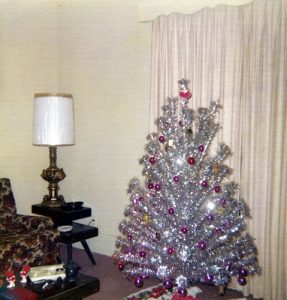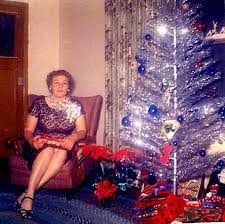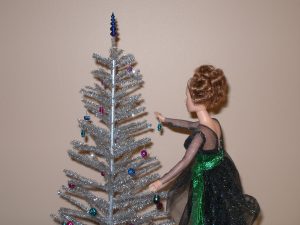
Until the year I turn 10, Christmas is the highlight of my year. I am such a freak for Yuletide that, starting in July, I write letters to my aunts and uncles telling them what gift I hope to receive for Christmas.
My parents choreograph this family tableau to imbue my brothers and me with the holiday spirit -- to allow the aluminum Christmas tree to work its cunning magic. But instead of awe and delight, we feel nothing.
Everything feels special, charged: the excitement in grade school when teachers serve punch and cupcakes on the last day before Christmas vacation; the storybook feeling when neighbors string colored Christmas lights on their homes and snowmen, built from tumbleweed that blows into town during the Santa Ana winds, magically appear on front lawns.
In the modest Guthmann living room in West Covina, California, each year we have a fragrant Christmas tree, covered in tinsel and dazzled with red, green, silver and blue Christmas bulbs. A meager Santa Claus, made from cotton, stands on top instead of an angel — until, that is, a rat invades the box of Christmas decorations stored in the attic.
By the end of each December, the tree has shed hundreds of needles on the living-room carpet, bringing no holiday cheer to my father. Each year he grouses about the mess, the cleanup, the bother of schlepping the tree to the curb on garbage day. Finally, in the year I turn 10, he makes the unilateral decision to purchase an aluminum Christmas tree.
“With an aluminum tree,” Dad explains, “you buy it just once and save the cost of purchasing a new tree each Christmas. It might last five, 10 years or more. Think of the money you save.” At no point do notions of beauty and aesthetic pleasure, tradition or the comforting fragrance of pine enter the discussion. All concerns are obliterated by an object lesson in thrift.
 The aluminum Christmas tree arrives in a large rectangular cardboard box. Each year, from fifth grade until I graduate from high school, the entire family will gather in the living room where my brothers and I assemble the tree under my parents’ supervision. There are three wooden posts, coated in shiny silver paper, that join together to form a trunk. The branches come next: dozens of them individually wrapped in long, thin, brown-paper sleeves and covered with hundreds of “needles” made from aluminum foil.
The aluminum Christmas tree arrives in a large rectangular cardboard box. Each year, from fifth grade until I graduate from high school, the entire family will gather in the living room where my brothers and I assemble the tree under my parents’ supervision. There are three wooden posts, coated in shiny silver paper, that join together to form a trunk. The branches come next: dozens of them individually wrapped in long, thin, brown-paper sleeves and covered with hundreds of “needles” made from aluminum foil.
Each branch has to be carefully removed from its brown-paper sleeve, lest the tiny strips of foil bend and wrinkle. Working from the top down, my brothers Danny, Davey and I insert each branch into evenly spaced holes drilled into the trunk. Ornaments come next. No electric lights, please. “The tree can become charged with electricity from faulty lights,” the Consumer Product Safety Commission warns after the first aluminum trees go on the market, “and a person touching a branch could be electrocuted.”
The tree isn’t finished yet. The piece de resistance is the rotating color wheel that sits on the floor and shoots swaths of spinning color up through the tree. A plastic disc attaches to the wheel, with kidney-shaped gels projecting red, green, blue and amber.
 In the year I turn 10, when the aluminum tree is brand-new to our living room, our family sits in a circle and, with no small amount of ceremony, stares at the finished tree. Andy Williams sings syrupy Christmas carols on the stereo. The stockings are hung. My parents choreograph this family tableau to imbue my brothers and me with the holiday spirit — to allow the aluminum tree to work its cunning magic.
In the year I turn 10, when the aluminum tree is brand-new to our living room, our family sits in a circle and, with no small amount of ceremony, stares at the finished tree. Andy Williams sings syrupy Christmas carols on the stereo. The stockings are hung. My parents choreograph this family tableau to imbue my brothers and me with the holiday spirit — to allow the aluminum tree to work its cunning magic.
But instead of awe and delight, we feel nothing. This artificial tree is cold, soulless.
It may be that hindsight adds a coating of cynicism to my tale– the feeling that this aluminum tree, as my brother Dave wisecracked much later, was “a form of child abuse” that robbed us of a proper Christmas. But my recollection is that, even then, we thought it was tacky.
It’s significant that this story takes place in the early 1960s, when space-age design and anything “futuristic” gains cultural currency and “The Jetsons” becomes a huge hit on prime-time television. And really, what could be more “Jetsons” than an aluminum Christmas tree?
Apparently, a lot of people agreed. Between 1959 and 1969, the Aluminum Specialty Company of Manitowoc, Wisconsin, produced more than one million aluminum Christmas trees. They retailed for $25 apiece – roughly $200 in today’s economy.
 Why would anyone spend so much? According to the Sears 1963 Christmas Book, the reasons were abundant: “Whether you decorate with blue or red balls, or use the tree without ornaments,” Sears enthused, “this exquisite tree is sure to be the talk of your neighborhood. High-luster aluminum gives a dazzling brilliance. Shimmering silvery branches are swirled and tapered to a handsome realistic fullness … It’s really durable. You can use it year after year.”
Why would anyone spend so much? According to the Sears 1963 Christmas Book, the reasons were abundant: “Whether you decorate with blue or red balls, or use the tree without ornaments,” Sears enthused, “this exquisite tree is sure to be the talk of your neighborhood. High-luster aluminum gives a dazzling brilliance. Shimmering silvery branches are swirled and tapered to a handsome realistic fullness … It’s really durable. You can use it year after year.”
I realize I’ve told this story at the expense of my father, who thought he’d done a wise and prudent thing by buying an aluminum tree that could be reused year after year; and maybe also at the expense of my mother, who may have hated the tree for all those years but kept quiet in order to maintain peace in the household.
What I didn’t appreciate until much later is that during this time, my father was struggling to support a family of five with the income from his Western Auto store in West Covina. Western Auto was a national chain and its stores were like junior-size versions of Sears: auto parts, electrical and plumbing, bicycles, furniture. The profit margin on that store had to be minimal, meaning that Dad’s decision to bring a fake tree into our house – and to make us look at it for the next 10 years — wasn’t the product of “Bah, Humbug!” stinginess, but financial necessity.
As the mid-1960s passed, the aluminum Christmas tree would fall out of favor in American homes, gathering dust in basements and attics, or selling at yard sales for as little as 25 cents. According to Wikipedia, A Charlie Brown Christmas contributed significantly to its demise. You may remember Charlie and Linus encountering a display of aluminum trees in that 1965 television classic, and turning away in disgust. Charlie instead chooses a small, scrawny sapling — symbolically casting his vote for authenticity over crass commercialism.
In 1970, my father would unload the Western Auto store and open a bicycle store, which proved by far the biggest financial success of his life. The timing was perfect: with the energy crunch of the early ’70s, and the push toward fitness among adults, you suddenly saw people of all ages riding bicycles in suburban Southern California.
I’d like to report that once the business took off and Dad’s nest was feathered more nicely, he gladly took that damn aluminum tree, its individually wrapped branches and its rotating color wheel, threw the whole mess in the garbage and brought home a genuine, live Christmas tree.
But he never did. And my mother, presuming she even had a desire for one, never requested it. Neither one of them was what you’d call aesthetically inclined, and neither ever lost the habit of parsimony they’d learned as children of the Depression.
That’s almost the end of this story. Weirdly enough, the aluminum Christmas tree never disappeared altogether and in fact scored an unexpected comeback. In the new millennium, they started selling online at high premiums: In 2005, a rare 7-foot-tall pink aluminum Christmas tree sold on the internet for $3,600.
 The trees have even appeared in museum collections. In 2004 Wisconsin artists and aluminum tree enthusiasts John Shimon and Julie Lindemann published the photography book Season’s Gleamings: The Art of the Aluminum Christmas Tree in a bright pink cover. I’m tempted to buy a copy — but not quite.
The trees have even appeared in museum collections. In 2004 Wisconsin artists and aluminum tree enthusiasts John Shimon and Julie Lindemann published the photography book Season’s Gleamings: The Art of the Aluminum Christmas Tree in a bright pink cover. I’m tempted to buy a copy — but not quite.
Once celebrated, later reviled, and now an object of retro kitsch, the aluminum tree may be here to stay. Somewhere, my late father, a true early adopter, is feeling proud of his foresight. And his thrift.




Oh Edward, you got me with the rotating color wheel! My favorite aunt and uncle (whom we spent Christmas with every year) had one of these trees, but I never realized that the wheel was the only light. I thought their tree was cool, but you’re right somehow otherworldly. Later when they moved to a bigger house it was just for show in the living room–there was a much larger real tree in the family room. We also had the three-light pole lamp in your picture, weren’t we all so au-courant?
I well remember the debate about aluminum trees, and your story recalls how artificial they seemed. But I especially like the way it expands from your reaction to it as cold and soulless, to the values and concerns of your father (who put it there) and mother (who tolerated it). It really is a love story, isn’t it?
I love the way this story weaves in so many threads: childhood memory, adult reflection and changed perspective, and a look at how and why parents did the things they did for reasons that elude children. This piece recalls the magic that was Christmas for this writer, and lets us see it through his eyes. I also appreciate the way the story encompassed the way those trees became a thing, and how they have now achieved retro status!
Wow!! We had that same tree with the lights and only RED balls!!. It lived in the living room picture window so you could see it from the street, rotating blue, yellow red. We had a real tree in the family room for all of our tacky paper chains and dumb ornaments. We weren’t allowed in the living room anyway, so the tree had the place to itself!